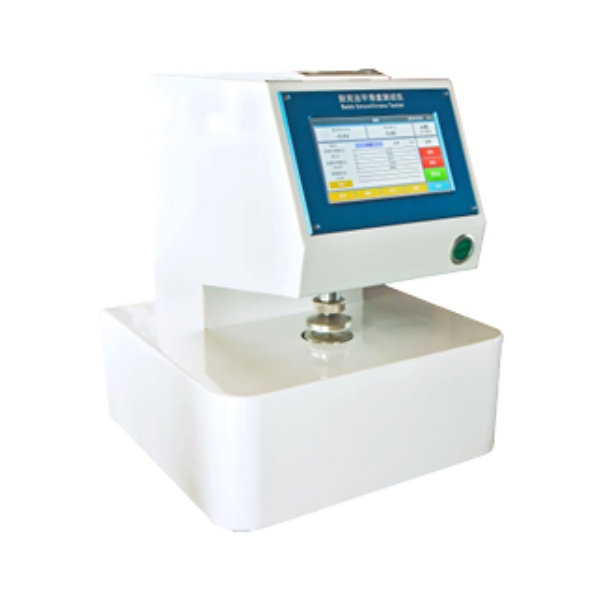Bekk Smoothness Tester & Related Standard
Smoothness Tester
Accurate and Efficient Bekk Smoothness Test for Paper and Board
About Us
Smoothness Tester
In quality control of paper and board products, smoothness test is a critical indicator that directly affects print quality, coating uniformity, and product performance. The ST-01 Smoothness Tester by Cell Instruments offers a high-precision, automated solution for evaluating the smoothness of paper using the internationally recognized Bekk method. This instrument provides reliable, repeatable measurements compliant with ISO 5627, DIN 53107, and TAPPI T479, making it a key tool for paper mills, packaging manufacturers, and testing laboratories worldwide.

Reliable Bekk Smoothness Testing for Quality Assurance
Smoothness Tester
In quality control of paper and board products, smoothness test is a critical indicator that directly affects print quality, coating uniformity, and product performance.
Add Your Heading Text Here
Lorem ipsum dolor sit amet, consectetur adipiscing elit. Ut elit tellus, luctus nec ullamcorper mattis, pulvinar dapibus leo.
Add Your Heading Text Here
Lorem ipsum dolor sit amet, consectetur adipiscing elit. Ut elit tellus, luctus nec ullamcorper mattis, pulvinar dapibus leo.
Main Functions and Advantages of the Bekk Smoothness Tester
Modern Bekk smoothness testers from Cell Instruments combine automation, precision and user‑friendliness:
- One-button operation for full automation and simplified testing
- Precision control using a stepper motor and high-accuracy (100±0.5kPa) load sensor
- No-impact pressing system prevents sample deformation or damage
- No-impact pressing system prevents sample deformation or damage
- 32-bit ARM CPU ensures fast, accurate data processing
- 7-inch color touch screen for intuitive interface and real-time data display
- Intelligent vacuum detection with auto-range switching for diverse samples
- Embedded micro-printer for immediate report printing
- Maintenance-free vacuum system with imported oil-free pumps
Bekk Smoothness Tester Key Advantages:
01
Consistency
Accurate, repeatable smoothness Bekk readings.
02
Speed
One‑button operation; no manual vacuum adjustments.
03
Adaptability
Suitable for a wide range of coating and printing‑grade papers.
These features combine to deliver industry-leading performance in surface smoothness test applications.
Prefix describing what your business does will be here
Brief Description of the Bekk Test Method
The Bekk smoothness test method measures how long it takes for a specified volume of air to pass between a sample and a reference surface under controlled vacuum conditions. Here’s a simplified overview of the test process:
- Place the test specimen on a precision glass plate.
- Apply a uniform pressure of 100 kPa using a calibrated pressure plate.
- Create a vacuum in a calibrated chamber (large or small, depending on sample).
- Measure the time required for the vacuum to drop between two pressure points.
- Record the result as the Bekk smoothness value, in seconds.
The Smoothness Tester enables this process automatically, complying with standards such as:
01
ISO 5627:1995
Paper and board — Determination of smoothness (Bekk method)
02
DIN 53107
Testing of paper and board – Determination of the smoothness by the Bekk method
03
TAPPI T479 cm‑21
Smoothness of paper (Bekk method), Test Method T 479 cm-21
03
GB/T 456‑2002
Chinese standard for Bekk smoothness measurement
Applicable Fields and Typical Applications
Printing industry
Ensures substrates support high‑definition graphics.
Coating & laminating
Controls surface porosity for consistent coat weights.
Packaging
Guarantees barrier materials exhibit uniform surface properties.
Specialty papers
Validates fine paper, security paper and label stocks.
Why Choose Cell Instruments?
As a leading manufacturer of material testing instruments, Cell Instruments combines precision engineering with deep industry expertise. Here’s what sets us apart:
- Proven quality: Decades of experience serving top-tier clients in packaging, paper, medical, and electronics industries
- Customization service: Tailored solutions to fit unique materials and testing challenges
- Expert support: Pre-sale consultations, operator training, and responsive after-sales service
- Reliable delivery: Export-ready systems with multilingual documentation and global compliance
With our ST-01 Smoothness Tester, you’re not just buying an instrument—you’re gaining a dependable quality assurance partner.
Why Smoothness Testing Is Essential?
Understanding the smoothness of paper helps manufacturers and converters make informed decisions about raw materials, coatings, and processing methods. The Bekk test provides a quantitative measure of surface flatness, directly impacting:
- Print clarity and ink coverage
- Coating uniformity
- Material bonding in lamination
- Sealing efficiency in packaging
Without accurate smoothness data, products risk inconsistent performance, customer complaints, and rejected batches—especially in high-value or sensitive applications.
ST-01 Smoothness Tester
Technical Specifications

| Parameter | Specification |
| Test area | (10±0.05) cm² |
| Measuring range | (1-9999)S, (1-15)S, (15~300) S, (300~9999) S, three range switch |
| Volume | Big Vacuum 380±1ml; Small Vacuum (38±1) ml |
| Vacuum range | I gear 50.66kPa -> 29.33kPa |
| II gear 50.66kPa -> 48kPa | |
| III gear:50.66kPa -> 48kPa | |
| Test Pressure | (100±2) kPa (Automatic pressure) |
| Dimension | 380x360x465 mm |
| Power | AC 220V 50Hz |
Frequently Asked Questions about Bekk Smoothness Test
What is the main purpose of a smoothness test?
It measures the surface evenness of paper or board to evaluate its suitability for printing, coating, and sealing applications.
How does the ST-01 differ from other Bekk smoothness testers?
The ST-01 features automatic pressure application, intelligent range detection, and a user-friendly touch interface for faster, more accurate testing.
Is the Bekk smoothness test suitable for very smooth or rough paper types?
It is best for smooth to moderately smooth samples. For extremely smooth or very rough samples, special vacuum chambers or alternate methods may be needed.
What is the difference between Bekk smoothness and Parker smoothness?
Bekk tests air flow under vacuum conditions, while Parker uses oil to fill surface voids under pressure; Bekk is preferred for printing‑grade papers.
Does paper thickness affect smoothness readings?
Materials up to 0.5 mm are suitable; thicker or highly permeable boards can skew results due to air leakage through the substrate.


Get in touch
No. 5577 Gongyebei Rd, Licheng, Jinan, 250109, Shandong, P.R.C.
marketing@celtec.cn
+86 185 6001 3985
